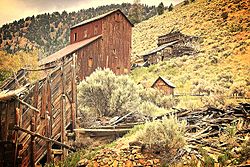
The Clark Fork, or the Clark Fork of the Columbia River, is a river in the U.S. states of Montana and Idaho, approximately 310 miles (500 km) long. The largest river by volume in Montana, it drains an extensive region of the Rocky Mountains in western Montana and northern Idaho in the watershed of the Columbia River. The river flows northwest through a long valley at the base of the Cabinet Mountains and empties into Lake Pend Oreille in the Idaho Panhandle. The Pend Oreille River in Idaho, Washington, and British Columbia, Canada which drains the lake to the Columbia in Washington, is sometimes included as part of the Clark Fork, giving it a total length of 479 miles (771 km), with a drainage area of 25,820 square miles (66,900 km2). In its upper 20 miles (32 km) in Montana near Butte, it is known as Silver Bow Creek. Interstate 90 follows much of the upper course of the river from Butte to Saint Regis. The highest point within the river's watershed is Mount Evans at 10,641 feet (3,243 m) in Deer Lodge County, Montana along the Continental Divide.
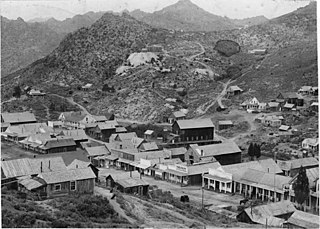
Silver City is a ghost town in northwestern Owyhee County, Idaho, United States, that is listed on the National Register of Historic Places (NRHP). At its height in the 1880s, it was a gold and silver mining town with a population of around 2,500 and approximately 75 businesses.

Belmont is a ghost town in Nye County, Nevada, United States along former State Route 82. The town is a historic district listed in the National Register of Historic Places. It is Nevada Historical Marker number 138.

Ward Charcoal Ovens State Historic Park is an area designated for historic preservation and public recreation located 20 miles (32 km) south of the town of Ely in White Pine County, Nevada. The 700-acre (280 ha) state park protects beehive-shaped charcoal ovens constructed in the latter half of the 19th century.

Ashcroft is an extinct mining town located in Pitkin County, Colorado, United States. The silver mining camp was founded as Castle Forks City in the spring of 1880. A post office named Ashcroft operated at the site from August 12, 1880, until August 5, 1881, when the name was changed to Chloride. The Chloride post office operated until January 3, 1882 when the name was changed back to Ashcroft. The renamed Ashcroft post office finally closed on November 30, 1912.

The Katahdin Iron Works is a Maine state historic site located in the unorganized township of the same name. It is the site of an ironworks which operated from 1845 to 1890. In addition to the kilns of the ironworks, the community was served by a railroad and had a 100-room hotel. The site was listed on the National Register of Historic Places in 1969.

Atlanta is an unincorporated community in the western United States, located in Elmore County, Idaho.

New Fork is a ghost town in Sublette County, Wyoming, United States, near Boulder. It was one of the earliest settlements in the upper Green River valley. New Fork was established in 1888 by John Vible and Louis Broderson, Danish immigrants who had arrived in the United States in 1884. They established a store along the Lander cut-off of the Oregon Trail. By 1908 a small town had grown around the store, and in 1910 Vible built a dance hall, called The Valhalla.

Leesburg is an unincorporated community in Lemhi County, Idaho, United States. It lies at 45°13′26″N114°6′50″W, along Napias Creek in the Salmon National Forest, west of Salmon. Its altitude is 6,653 feet (2,028 m).

The Berlin Historic District encompasses the ghost town of Berlin in Nye County, Nevada. The town was established in 1897 as part of the Union Mining District after the opening of the Berlin Mine the previous year. The name is a transfer from Berlin, in Germany, the native land of a share of the local prospectors. The town never prospered to the same extent as other boom towns like Tonopah and Goldfield, and declined following the Panic of 1907. The town was largely abandoned by 1911. The site was acquired by the state of Nevada as part of Berlin–Ichthyosaur State Park in 1970.

Bristol Wells, also known as National City, Bristol City and Tempest, is a ghost town in Lincoln County, Nevada. The mining town was located on the west side of Bristol Mountain, 14 miles (23 km) northwest of Pioche, Nevada.

The Silver City Historic District is a historically significant mining area in northwestern Owyhee County, Idaho, United States. It includes the abandoned town of Silver City and numerous nearby towns, mines, and mining remains, covering approximately 16 square miles (41 km2). Along with Silver City, it encompasses the communities of Ruby City, Boonsville, Dewey, and Fairvlew, along with major silver mines on War Eagle Mountain and Florida Mountain.
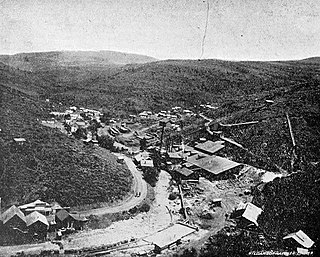
De Lamar is a ghost town in Owyhee County, Idaho, United States. Its elevation is 5,463 ft (1,665 m), and it is approximately 6 mi (9.7 km) west of Silver City. The community lies within an area governed by the Bureau of Land Management.

Custer is a ghost town in Custer County, Idaho, United States. Established in 1877, it is at 44°23′15″N114°41′45″W, at an elevation of 6,470 feet (1,972 m). It lies along Yankee Fork Road southwest of the city of Challis, within the Challis National Forest.

Old Irontown, Old Iron Town, or Irontown, originally Iron City, is an unincorporated community and near-ghost town in Iron County, Utah, United States. It is located in Dixie National Forest, approximately 22 miles (35 km) from Cedar City. The settlement was founded in 1868 as a second attempt to mine iron from Iron Mountain after a disappointing yield from Cedar City. The colony lasted until 1876, when strife from the Edmunds–Tucker Act and the Panic of 1873 forced its closure. The site was added to the National Register of Historic Places in 1971.
Dutchtown was a mining community high in the Never Summer Mountains of what is now Rocky Mountain National Park. The ghost town lies just below the timberline, and comprises the ruins of four cabins. The site was inhabited by squatters who were made unwelcome in Lulu City, in the Kawuneeche Valley a couple of miles to the east. Dutchtown existed to work the same silver deposits mined by Lulu City residents, but existed as a suburb of Lulu City to accommodate Dutch miners who were run out of town after a drunken affray in Lulu City. It existed from about 1879 to about 1884.
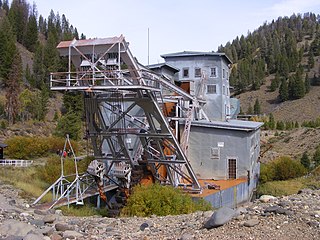
Land of the Yankee Fork State Park is a history-oriented public recreation area covering 521 acres (211 ha) in Custer County, Idaho, United States. The state park interprets Idaho's frontier mining history, including the ghost towns Bayhorse, Bonanza, and Custer. The interpretive center near Challis has a museum and gold panning station. The park was created in 1990 with the purchase of twenty acres where the interpretive center is located two miles south of Challis. It is operated by the Idaho Department of Parks and Recreation in cooperation with the United States Forest Service.

The Birch Creek Charcoal Kilns are a group of beehive-shaped clay charcoal kilns near Leadore, Idaho, built in 1886. They were listed on the National Register of Historic Places in 1972.
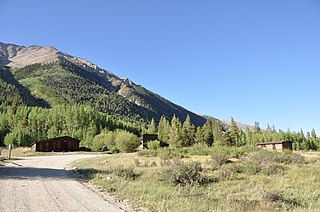
Winfield is a ghost town in Chaffee County, Colorado, United States. It is estimated that as many as 1,500 people may have lived in Winfield.

The Frisco Charcoal Kilns are remnants of silver mining in the Utah ghost town of Frisco. They remain as a visual documentation of the state's mining history
